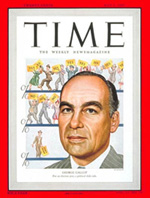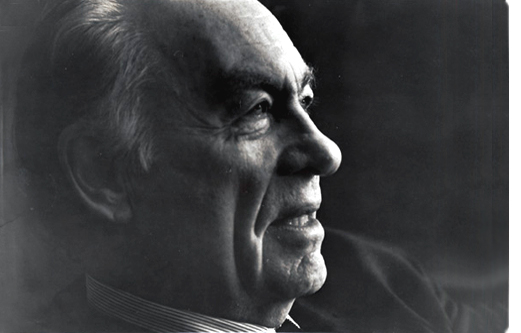 One of
America's 10 Outstanding Young Men
One of
America's 10 Outstanding Young MenU.S. Jaycees, 1938. Others on this list include: Orson Welles, Rudy Vallee and Howard Hughes.
One of the 64 Who Run America
John Gunther, The 64 Who Run America, 1947
New wielders of power have replaced Ambassador Gerards's famous list of tycoons, says the author
of INSIDE AMERICA. Others on this list include:
Truman, Clifford, Snyder, Byrnes, Marshall, McCoromick, Hearst, Sarnoff and Luce.
1000 Makers of the Twentieth Century
Times Newspapers Limited (England), 1971, 1972 (Book based on articles.)
George Gallup: His name has been attached to a new dimension in modern politics. A psychologist by training, he left his professorship in journalism in 1932 to be director of research for a New York advertising agency. As a side-line he launched, in 1935, the American Institute of Public Opinion to undertake regular 'Gallup' surveys on public issues, using the established techniques of market research for syndication across the United States in a variety of newspapers. It was the presidential election of 1935 which put 'Gallup' polls on the map. Till then election forecasting had been monopolized by the 'straw-vote', notably the Literary Digest's. That year on the basis of more than two million postal ballots, the Digest predicted a defeat for Roosevelt. Gallup and others, by interviewing diminutive but 'representative' samples, correctly predicted Roosevelt's victory. This taught people that bigger opinion polls are not necessarily better. The discomfiture of the pollsters came in 1948 when they all wrongly predicted a defeat for Truman, but their subsequent record redeemed their reputation. R.J.E.S.
('Gauging Public Opinion,' H. Cantril, Princeton, NJ, 1944. 'Survey Methods in Social Investigation' by C.A. Moser Heineman, 1958.)
50 Who Made the Difference
Esquire, December 1983. "The goal was to select individuals - men and women - some living, some dead, all American citizens, who had made a significant difference in today's world through individual effort in their chosen field." Article by Richard Reeves
"Using methodical means, George Gallup made it possible to know what the people are thinking, issue by issue, moment to moment. Before Gallup democracy was an exercise in guesswork; letters from constituents, the results of infrequent elections. Elected officials can now feel the public pulse more accurately, and one might assume they have become more sensitive to the voters' wishes. Gallup's methods also changed marketing; product testing and advertising campaigns are only two of the areas today that are dependent on how the numbers come out. Indeed, statistics is now unto itself big business. And George Gallup is its Henry Ford."
"GEORGE GALLUP'S NATION OF NUMBERS. Selling soup or selling Presidents - it came to pass that the product was only as good as the percentages."
The 100 Most Important Americans of the 20th Century
Life, 1990 (Fall Special Issue) George Gallup - The Pollster Figured Out How to Take the Public's Pulse
"In the summer of 1922 the St. Louis Post-Dispatch hired college students to question every reader about the newspaper's contents. One footsore door-to-door canvasser decided to devise a more efficient method; six years later George H. Gallup earned a Ph.D. with his thesis that public opinion could be collected from a very small sample, if selected scientifically."
The 100 Most Influential Americans of All Time
Atlantic, December 2006. George Gallup - #82 (between Margaret Mead (#81) and James Fenimore Cooper (#83)
"He asked Americans what they thought, and the politicians listened."


